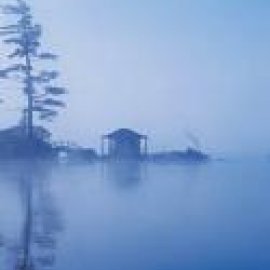Sacred Places: A Special New Year Edition
-
English
-
ListenPause
I'm Peter Neill, director of the World Ocean Observatory. As the year turns, we think of renewal, beginnings rather than ends, hopes instead of fears. For many, the traditions of formal religions provide the words and order of these preoccupations, for others private thoughts and special places provide. In each of these, nature plays some part, as allegory, animation of the divine, or sacred spaces where in we find the source and strength for the future. Many such spaces exist alongshore throughout the world, as both symbol and reality of complex, intangible relationship between us and our originating web of life. The ocean itself is frequently invoked for its emotional depth and dynamic breadth as a metaphor for freedom from life’s burdens and tyrannies and for opportunity for passage into the future. In a recent collection of essays, Sacred Natural Sites, Conserving Nature & Culture (Earthscan, 2010), the Editors discuss this phenomenon worldwide. Among many examples, islands hold special meaning -- Lindisfarne Island, for instance, that since 635 AD has been a holy site for Christian pilgrimage linking nature and spirituality. Located on the northeast coast of England at the Scottish border, Lindisfarne is surrounded by rich wetlands, and is accessible only at low tide, across sand and mud flats marked by an ancient pilgrim’s path and a modern causeway, today home to a resident community of 150 and to half a million visitors per year who come a place that housed for centuries Christian monastic communities and nurtured the lives of saints. Primary among them is St. Cuthbert, described as “one of the most important saints of Medieval England and Europe,” whose affinity for nature, seabirds, and the protection of wildlife and wild places foreshadowed the modern conservation movement. There are many other examples, in Ireland, France, the South Pacific region, Africa, India, Japan, and elsewhere. In the Philippines, on Coron Island, off Palawan, the indigenous Calamian Tagbanwa people have defined ten sacred areas in the sea where they believe divine spirits dwell and which must be protected as sanctuaries from which fishing, dropping of anchors, or culturing seaweed are prohibited. These sites can only be entered by shamans, elders, and worshippers whose prayers name and invoke the wide variety of marine species and natural physical characteristics of the areas, thereby connecting spiritual beliefs with natural phenomenon through unique personal and community religious practice. Amazingly, such places have found allies in the biodiversity protection movement and associated governance designed to conserve the fulsome catalogue of species and habitat typically coexisting with sacred spaces. Research studies, management practices, legal instruments, education and training projects abound, justifying protections, providing models and international conventions, and establishing communications and enforcement methods that meet the goals of both religionist and conservationist. What are the premises on which this unexpected coalition is based? First, there is a real and widespread interconnection between sacred spaces and bio-diverse areas around the world. Second, the degradation of one threatens the integrity of the other, and these degradations are accelerating and destructive to the value of both. Third, faith, spirituality, and science are different but complementary ways of understanding human-nature relationships, and the protection of places where all three intersect can be seen as a means to sustain ecologically sound ways of life. And fifth, by virtue of these premises, a strategy to build public awareness, supportive policies and laws, and other local, national, and international actions is worthwhile and urgently needed. Should we not all have such places – a river or lake to sit by, a beach to walk, a space in which to reflect and renew? We will discuss these issues and more in future editions of World Ocean Radio. WORLD OCEAN RADIO IS A PROJECT OF THE WORLD OCEAN OBSERVATORY, IN ASSOCIATION WITH WERU-FM, BLUE HILL, MAINE. WORLD OCEAN RADIO IS DISTRIBUTED BY THE PUBLIC RADIO EXCHANGE AND THE PACIFICA NETWORK. FIND OUR PODCAST ON ITUNES, AND AT WORLD OCEAN OBSERVATORY DOT ORG.
In this New Year’s episode of World Ocean Radio, host Peter Neill details a number of sacred places around the globe--on islands, along the shore, on the banks of rivers, lakes and streams--and the allies that these spaces have found in protective movements, enforcement, and international action. He outlines the relationship of biodiverse regions around the world to their sacred and scientific importance, and how conservation justifies protection while simultaneously meeting the goals of religionists and conservationists alike.
About World Ocean Radio
World Ocean Radio provides coverage of a broad spectrum of ocean issues from science and education to advocacy and exemplary projects. World Ocean Radio, a project of the World Ocean Observatory, is a weekly series of five-minute audio essays available for syndicated use at no cost by college and community radio stations worldwide. A selection of episodes is available in Portuguese, Spanish, French, Swahili, and Mandarin, enabling us to reach 75% of the world's population. For more information, visit WorldOceanObservatory.org/world-ocean-radio-global.
- Login to post comments



